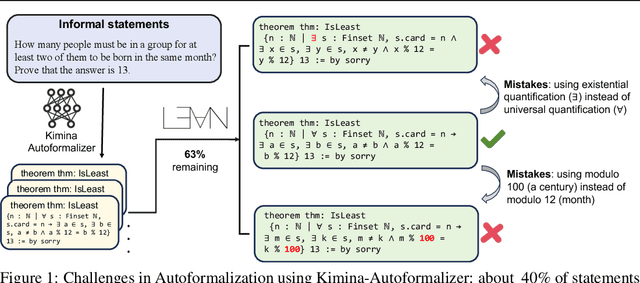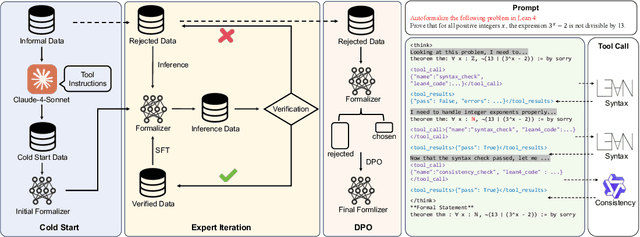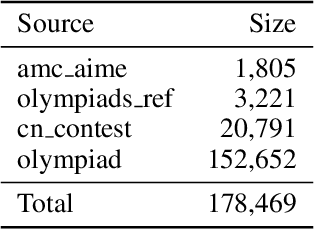Jingang Wang
Efficient Context Scaling with LongCat ZigZag Attention
Dec 30, 2025Abstract:We introduce LongCat ZigZag Attention (LoZA), which is a sparse attention scheme designed to transform any existing full-attention models into sparse versions with rather limited compute budget. In long-context scenarios, LoZA can achieve significant speed-ups both for prefill-intensive (e.g., retrieval-augmented generation) and decode-intensive (e.g., tool-integrated reasoning) cases. Specifically, by applying LoZA to LongCat-Flash during mid-training, we serve LongCat-Flash-Exp as a long-context foundation model that can swiftly process up to 1 million tokens, enabling efficient long-term reasoning and long-horizon agentic capabilities.
A Survey on LLM Mid-training
Oct 27, 2025Abstract:Recent advances in foundation models have highlighted the significant benefits of multi-stage training, with a particular emphasis on the emergence of mid-training as a vital stage that bridges pre-training and post-training. Mid-training is distinguished by its use of intermediate data and computational resources, systematically enhancing specified capabilities such as mathematics, coding, reasoning, and long-context extension, while maintaining foundational competencies. This survey provides a formal definition of mid-training for large language models (LLMs) and investigates optimization frameworks that encompass data curation, training strategies, and model architecture optimization. We analyze mainstream model implementations in the context of objective-driven interventions, illustrating how mid-training serves as a distinct and critical stage in the progressive development of LLM capabilities. By clarifying the unique contributions of mid-training, this survey offers a comprehensive taxonomy and actionable insights, supporting future research and innovation in the advancement of LLMs.
Autoformalizer with Tool Feedback
Oct 08, 2025



Abstract:Autoformalization addresses the scarcity of data for Automated Theorem Proving (ATP) by translating mathematical problems from natural language into formal statements. Efforts in recent work shift from directly prompting large language models to training an end-to-end formalizer model from scratch, achieving remarkable advancements. However, existing formalizer still struggles to consistently generate valid statements that meet syntactic validity and semantic consistency. To address this issue, we propose the Autoformalizer with Tool Feedback (ATF), a novel approach that incorporates syntactic and consistency information as tools into the formalization process. By integrating Lean 4 compilers for syntax corrections and employing a multi-LLMs-as-judge approach for consistency validation, the model is able to adaptively refine generated statements according to the tool feedback, enhancing both syntactic validity and semantic consistency. The training of ATF involves a cold-start phase on synthetic tool-calling data, an expert iteration phase to improve formalization capabilities, and Direct Preference Optimization to alleviate ineffective revisions. Experimental results show that ATF markedly outperforms a range of baseline formalizer models, with its superior performance further validated by human evaluations. Subsequent analysis reveals that ATF demonstrates excellent inference scaling properties. Moreover, we open-source Numina-ATF, a dataset containing 750K synthetic formal statements to facilitate advancements in autoformalization and ATP research.
Making Mathematical Reasoning Adaptive
Oct 06, 2025



Abstract:Mathematical reasoning is a primary indicator of large language models (LLMs) intelligence. However, existing LLMs exhibit failures of robustness and generalization. This paper attributes these deficiencies to spurious reasoning, i.e., producing answers from superficial features. To address this challenge, we propose the AdaR framework to enable adaptive reasoning, wherein models rely on problem-solving logic to produce answers. AdaR synthesizes logically equivalent queries by varying variable values, and trains models with RLVR on these data to penalize spurious logic while encouraging adaptive logic. To improve data quality, we extract the problem-solving logic from the original query and generate the corresponding answer by code execution, then apply a sanity check. Experimental results demonstrate that AdaR improves robustness and generalization, achieving substantial improvement in mathematical reasoning while maintaining high data efficiency. Analysis indicates that data synthesis and RLVR function in a coordinated manner to enable adaptive reasoning in LLMs. Subsequent analyses derive key design insights into the effect of critical factors and the applicability to instruct LLMs. Our project is available at https://github.com/LaiZhejian/AdaR
Fine-tuning Done Right in Model Editing
Sep 26, 2025



Abstract:Fine-tuning, a foundational method for adapting large language models, has long been considered ineffective for model editing. Here, we challenge this belief, arguing that the reported failure arises not from the inherent limitation of fine-tuning itself, but from adapting it to the sequential nature of the editing task, a single-pass depth-first pipeline that optimizes each sample to convergence before moving on. While intuitive, this depth-first pipeline coupled with sample-wise updating over-optimizes each edit and induces interference across edits. Our controlled experiments reveal that simply restoring fine-tuning to the standard breadth-first (i.e., epoch-based) pipeline with mini-batch optimization substantially improves its effectiveness for model editing. Moreover, fine-tuning in editing also suffers from suboptimal tuning parameter locations inherited from prior methods. Through systematic analysis of tuning locations, we derive LocFT-BF, a simple and effective localized editing method built on the restored fine-tuning framework. Extensive experiments across diverse LLMs and datasets demonstrate that LocFT-BF outperforms state-of-the-art methods by large margins. Notably, to our knowledge, it is the first to sustain 100K edits and 72B-parameter models,10 x beyond prior practice, without sacrificing general capabilities. By clarifying a long-standing misconception and introducing a principled localized tuning strategy, we advance fine-tuning from an underestimated baseline to a leading method for model editing, establishing a solid foundation for future research.
IIET: Efficient Numerical Transformer via Implicit Iterative Euler Method
Sep 26, 2025



Abstract:High-order numerical methods enhance Transformer performance in tasks like NLP and CV, but introduce a performance-efficiency trade-off due to increased computational overhead. Our analysis reveals that conventional efficiency techniques, such as distillation, can be detrimental to the performance of these models, exemplified by PCformer. To explore more optimizable ODE-based Transformer architectures, we propose the \textbf{I}terative \textbf{I}mplicit \textbf{E}uler \textbf{T}ransformer \textbf{(IIET)}, which simplifies high-order methods using an iterative implicit Euler approach. This simplification not only leads to superior performance but also facilitates model compression compared to PCformer. To enhance inference efficiency, we introduce \textbf{I}teration \textbf{I}nfluence-\textbf{A}ware \textbf{D}istillation \textbf{(IIAD)}. Through a flexible threshold, IIAD allows users to effectively balance the performance-efficiency trade-off. On lm-evaluation-harness, IIET boosts average accuracy by 2.65\% over vanilla Transformers and 0.8\% over PCformer. Its efficient variant, E-IIET, significantly cuts inference overhead by 55\% while retaining 99.4\% of the original task accuracy. Moreover, the most efficient IIET variant achieves an average performance gain exceeding 1.6\% over vanilla Transformer with comparable speed.
TCPO: Thought-Centric Preference Optimization for Effective Embodied Decision-making
Sep 10, 2025



Abstract:Using effective generalization capabilities of vision language models (VLMs) in context-specific dynamic tasks for embodied artificial intelligence remains a significant challenge. Although supervised fine-tuned models can better align with the real physical world, they still exhibit sluggish responses and hallucination issues in dynamically changing environments, necessitating further alignment. Existing post-SFT methods, reliant on reinforcement learning and chain-of-thought (CoT) approaches, are constrained by sparse rewards and action-only optimization, resulting in low sample efficiency, poor consistency, and model degradation. To address these issues, this paper proposes Thought-Centric Preference Optimization (TCPO) for effective embodied decision-making. Specifically, TCPO introduces a stepwise preference-based optimization approach, transforming sparse reward signals into richer step sample pairs. It emphasizes the alignment of the model's intermediate reasoning process, mitigating the problem of model degradation. Moreover, by incorporating Action Policy Consistency Constraint (APC), it further imposes consistency constraints on the model output. Experiments in the ALFWorld environment demonstrate an average success rate of 26.67%, achieving a 6% improvement over RL4VLM and validating the effectiveness of our approach in mitigating model degradation after fine-tuning. These results highlight the potential of integrating preference-based learning techniques with CoT processes to enhance the decision-making capabilities of vision-language models in embodied agents.
OneCAT: Decoder-Only Auto-Regressive Model for Unified Understanding and Generation
Sep 03, 2025



Abstract:We introduce OneCAT, a unified multimodal model that seamlessly integrates understanding, generation, and editing within a novel, pure decoder-only transformer architecture. Our framework uniquely eliminates the need for external components such as Vision Transformers (ViT) or vision tokenizer during inference, leading to significant efficiency gains, especially for high-resolution inputs. This is achieved through a modality-specific Mixture-of-Experts (MoE) structure trained with a single autoregressive (AR) objective, which also natively supports dynamic resolutions. Furthermore, we pioneer a multi-scale visual autoregressive mechanism within the Large Language Model (LLM) that drastically reduces decoding steps compared to diffusion-based methods while maintaining state-of-the-art performance. Our findings demonstrate the powerful potential of pure autoregressive modeling as a sufficient and elegant foundation for unified multimodal intelligence. As a result, OneCAT sets a new performance standard, outperforming existing open-source unified multimodal models across benchmarks for multimodal generation, editing, and understanding.
Stop Spinning Wheels: Mitigating LLM Overthinking via Mining Patterns for Early Reasoning Exit
Aug 25, 2025



Abstract:Large language models (LLMs) enhance complex reasoning tasks by scaling the individual thinking process. However, prior work shows that overthinking can degrade overall performance. Motivated by observed patterns in thinking length and content length, we categorize reasoning into three stages: insufficient exploration stage, compensatory reasoning stage, and reasoning convergence stage. Typically, LLMs produce correct answers in the compensatory reasoning stage, whereas reasoning convergence often triggers overthinking, causing increased resource usage or even infinite loops. Therefore, mitigating overthinking hinges on detecting the end of the compensatory reasoning stage, defined as the Reasoning Completion Point (RCP). RCP typically appears at the end of the first complete reasoning cycle and can be identified by querying the LLM sentence by sentence or monitoring the probability of an end-of-thinking token (e.g., \texttt{</think>}), though these methods lack an efficient and precise balance. To improve this, we mine more sensitive and consistent RCP patterns and develop a lightweight thresholding strategy based on heuristic rules. Experimental evaluations on benchmarks (AIME24, AIME25, GPQA-D) demonstrate that the proposed method reduces token consumption while preserving or enhancing reasoning accuracy.
Too Consistent to Detect: A Study of Self-Consistent Errors in LLMs
May 23, 2025Abstract:As large language models (LLMs) often generate plausible but incorrect content, error detection has become increasingly critical to ensure truthfulness. However, existing detection methods often overlook a critical problem we term as self-consistent error, where LLMs repeatly generate the same incorrect response across multiple stochastic samples. This work formally defines self-consistent errors and evaluates mainstream detection methods on them. Our investigation reveals two key findings: (1) Unlike inconsistent errors, whose frequency diminishes significantly as LLM scale increases, the frequency of self-consistent errors remains stable or even increases. (2) All four types of detection methshods significantly struggle to detect self-consistent errors. These findings reveal critical limitations in current detection methods and underscore the need for improved methods. Motivated by the observation that self-consistent errors often differ across LLMs, we propose a simple but effective cross-model probe method that fuses hidden state evidence from an external verifier LLM. Our method significantly enhances performance on self-consistent errors across three LLM families.
 Add to Chrome
Add to Chrome Add to Firefox
Add to Firefox Add to Edge
Add to Edge